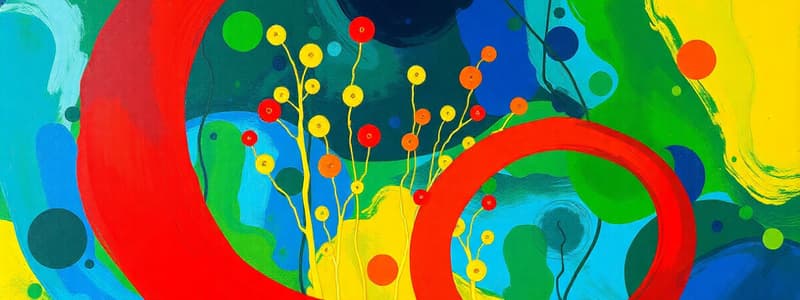Podcast
Questions and Answers
Which of the following is a requirement for photosynthesis?
Which of the following is a requirement for photosynthesis?
- Oxygen
- Carbon Dioxide (correct)
- Water (correct)
- Methane
Anoxygenic photosynthesis uses H2O as the electron donor.
Anoxygenic photosynthesis uses H2O as the electron donor.
False (B)
What is primary production primarily responsible for in an ecosystem?
What is primary production primarily responsible for in an ecosystem?
Main source of energy
In bottom-up control, factors that impact primary production include reduced nutrients, __________, and temperature.
In bottom-up control, factors that impact primary production include reduced nutrients, __________, and temperature.
Which mechanism is responsible for water mixing and nutrient provision in the photic zone?
Which mechanism is responsible for water mixing and nutrient provision in the photic zone?
Match the following terms related to primary production mechanisms:
Match the following terms related to primary production mechanisms:
The euphotic zone is characterized by a lack of light for photosynthesis.
The euphotic zone is characterized by a lack of light for photosynthesis.
Photosynthesis is represented by the chemical equation CO2 + H2O → __________ + O2.
Photosynthesis is represented by the chemical equation CO2 + H2O → __________ + O2.
What primarily drives the vertical mixing of water in lakes?
What primarily drives the vertical mixing of water in lakes?
Coastal upwelling brings nutrient-poor waters to the surface.
Coastal upwelling brings nutrient-poor waters to the surface.
Name one area where upwelling occurs due to large-scale ocean circulation.
Name one area where upwelling occurs due to large-scale ocean circulation.
Wind-driven upwelling enhances primary production in __________ waters.
Wind-driven upwelling enhances primary production in __________ waters.
Match the following upwelling types to their respective characteristics:
Match the following upwelling types to their respective characteristics:
What effect does the Coriolis force have on ocean currents?
What effect does the Coriolis force have on ocean currents?
Tropical waters are more productive than temperate waters due to continuous cooling.
Tropical waters are more productive than temperate waters due to continuous cooling.
What is the outcome of wind-driven coastal upwelling?
What is the outcome of wind-driven coastal upwelling?
What causes the upwelling driven by river runoff in estuaries?
What causes the upwelling driven by river runoff in estuaries?
Phytoplankton bloom occurs in winter due to a rise in temperature.
Phytoplankton bloom occurs in winter due to a rise in temperature.
What is a pycnocline?
What is a pycnocline?
Tidal currents can create __________ that can lead to the mixing of nutrient-rich bottom water.
Tidal currents can create __________ that can lead to the mixing of nutrient-rich bottom water.
Match the following features with their definitions:
Match the following features with their definitions:
Why might turbidity reduce phytoplankton production in tidally mixed waters?
Why might turbidity reduce phytoplankton production in tidally mixed waters?
Seasonal changes in temperature do not affect the water column's primary production.
Seasonal changes in temperature do not affect the water column's primary production.
What effect do strong winds have on the water column?
What effect do strong winds have on the water column?
Flashcards
Autotrophs
Autotrophs
Organisms that can produce their own food using energy from the sun or chemicals.
Photosynthesis
Photosynthesis
The process by which organisms use sunlight to convert carbon dioxide and water into glucose (sugar) and oxygen.
Chemosynthesis
Chemosynthesis
The process by which organisms use energy from chemicals to convert carbon dioxide and water into glucose (sugar) and other compounds.
Primary Production
Primary Production
Signup and view all the flashcards
Bottom-up Control
Bottom-up Control
Signup and view all the flashcards
Top-down Control
Top-down Control
Signup and view all the flashcards
Thermocline
Thermocline
Signup and view all the flashcards
Nutricline
Nutricline
Signup and view all the flashcards
Wind-driven Coastal Upwelling
Wind-driven Coastal Upwelling
Signup and view all the flashcards
Upwelling driven by Large-Scale Circulation
Upwelling driven by Large-Scale Circulation
Signup and view all the flashcards
Water Column
Water Column
Signup and view all the flashcards
Spring Phytoplankton Bloom
Spring Phytoplankton Bloom
Signup and view all the flashcards
Meromictic Lakes
Meromictic Lakes
Signup and view all the flashcards
Upwelling driven by River Runoff
Upwelling driven by River Runoff
Signup and view all the flashcards
Pycnocline
Pycnocline
Signup and view all the flashcards
Upwelling driven by Tidal Mixing
Upwelling driven by Tidal Mixing
Signup and view all the flashcards
Wind-driven vertical transport/upwelling (lakes)
Wind-driven vertical transport/upwelling (lakes)
Signup and view all the flashcards
Wind-driven coastal upwelling (oceans)
Wind-driven coastal upwelling (oceans)
Signup and view all the flashcards
Upwelling driven by large-scale circulation (oceans)
Upwelling driven by large-scale circulation (oceans)
Signup and view all the flashcards
Equatorial Upwelling
Equatorial Upwelling
Signup and view all the flashcards
Antarctic Divergence
Antarctic Divergence
Signup and view all the flashcards
Tropical Water Stratification
Tropical Water Stratification
Signup and view all the flashcards
Westward flowing currents along the equator
Westward flowing currents along the equator
Signup and view all the flashcards
Westward and Eastward Currents near Antarctic Coast
Westward and Eastward Currents near Antarctic Coast
Signup and view all the flashcards
Study Notes
Water Column-Primary Production
- Primary producers are autotrophs
- Photosynthesis equation: CO2 + H2O → CH2O + O2 (light, pigment)
- Oxygenic photosynthesis uses H2O as an electron donor
- Anoxygenic photosynthesis uses H2S as an electron donor
- Requirements for photosynthesis include carbon dioxide, water, nitrate, phosphate, trace elements, and light
- Organisms can fix CO2 using chemical energy in reduced environments (chemosynthesis)
- Primary production is the main energy source in ecosystems
Two-Models of Production and Energy Flux
- Bottom-up control factors directly impact primary production (e.g., nutrients, light, temperature)
- Top-down control factors affect organisms higher in the food chain
Bottom-up Control Mechanism of Primary Production
- Heat: Stratification (heating of surface water) creates a thermocline
- Light: The level at which 1% of surface light penetrates
- Nutrients: Stratification also affects nutrient distribution and vertical water mixing can break down stratification
Light
- Light intensity is the rate at which photons strike a given surface
- Light intensity varies in time and space
- Euphotic zone has enough light intensity for photosynthesis
- Clear oceanic/deep lake photosynthesis extends to approximately 100 meters
Nutrients
- Nutrient concentration in surface waters affects production
- Physical processes, like mixing, are important for distributing nutrients
- Seasonal changes in temperature and wind action can affect mixing
- Upwelling, driven by various factors such as river runoff, tidal waves, wind, and large-scale ocean circulation, brings nutrient-rich water to the surface
Seasonal Changes in Temperature
- Seasonal temperature changes (cooling and wind action) lead to phytoplankton blooms in spring and no growth in winter
- This is common in temperate lakes and oceans (up to 100-200m depth)
- Local factors influence specific water bodies
- Meromictic lakes lack complete mixing
Upwelling driven by river runoff-estuaries
- River water (less saline) rides over ocean saline water
- A pycnocline can develop when water is relatively calm
- Surface winds/waves generate waves, progressively continuing into the pycnocline, causing its instability
- Progressive mixing of fresh and salt water (entrainment) brings salt water upwards and filling the space of the entrained water
- Bottom water is enriched in nutrients
Upwelling driven by tidal mixing -estuaries
- Tides are caused by gravitational pull of the sun and moon which cause regular rise/fall of sea level varying by location
- Estuaries with high tidal ranges have strong currents that run on the rising and falling tide
- Tidal currents, moving over the bottom create turbulence that can break salinity stratification, resulting in tidally mixed estuaries
- Nutrient-rich bottom water comes to the surface
- Turbidity may reduce phytoplankton production in mixed waters compared to stratified waters.
Wind-driven vertical transport/upwelling-lakes
- Strong winds over lake surfaces blowing in one direction.
- Thermocline is depressed on one side of the lake, leading to a corresponding rise on the other side, which creates instability
- When winds cease, the unstable thermocline results in vertical water mixing
Wind-driven coastal upwelling-Oceans
- Longshore winds are converted into offshore winds.
- Nutrient-rich waters are brought to the surface, alongside optimal light and temperature conditions
- Resulting in enhanced primary production
Upwelling driven by large-scale circulation in the ocean.
- Equatorial upwelling: Tropical waters are stratified and less productive than temperate waters due to the lack of seasonal cooling, though upwelling can enhance production. Coriolis force influences currents
- Antarctic divergence: Water currents close to the Antarctic coast flow in opposite directions, causing upwelling. Coriolis force deflecting the two currents in opposite directions. This results in upwelling along the Antarctic coast, leading to high productivity associated with Antarctic divergence.
Conclusion
- Lakes and oceans can be seasonally or permanently stratified
- Supply of nutrients in the photic zone or the well-lit zone is sometimes reduced
- Breakdown of thermocline and vertical transport of water results in nutrient-rich water coming to the surface.
- Understanding mechanisms helps to understand the broad-scale distribution of production zones in open water.
Studying That Suits You
Use AI to generate personalized quizzes and flashcards to suit your learning preferences.




